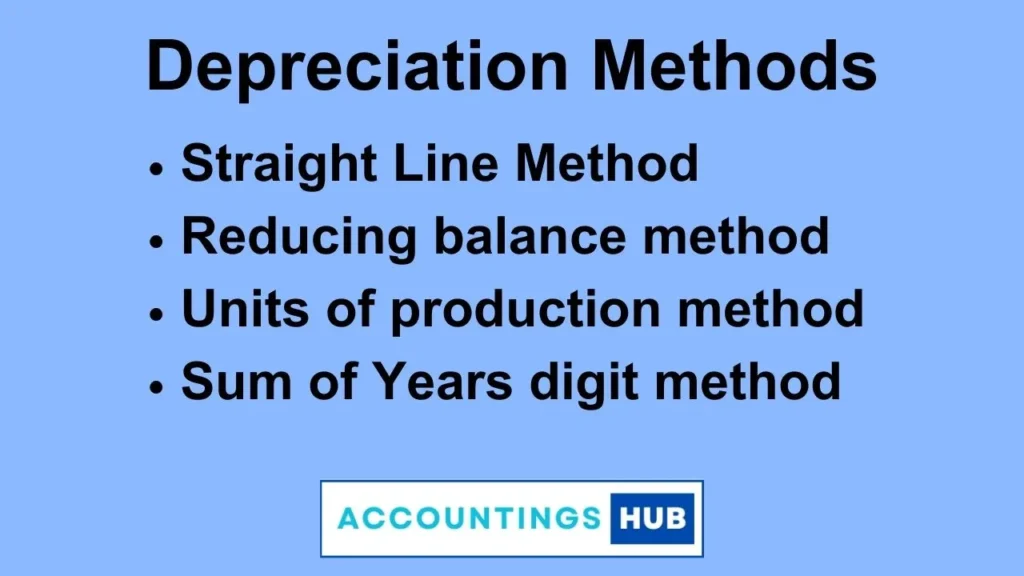A variety of depreciation methods can be used to allocate the depreciable amount of an asset on a systematic basis over its useful life. However, the depreciation method used should reflect as fairly as possible the pattern in which the asset’s economic benefits are expected to be consumed by the entity.

The four common methods of depreciation are discussed below:
- Straight Line Method
- Reducing balance method
- Units of production method
- Sum of Years digit method
Straight line depreciation
In this method, the depreciable amount is charged in equal amounts to each reporting period over the expected useful life of the asset. With the straight-line method, the annual depreciation charge is the same for each full financial year over the life of the asset. This is the most common method in practice and the easiest to calculate.
𝐷𝑒𝑝𝑟𝑒𝑐𝑖𝑎𝑡𝑖𝑜𝑛 = (𝐶𝑜𝑠𝑡−𝑅𝑒𝑠𝑖𝑑𝑢𝑎𝑙 𝑣𝑎𝑙𝑢𝑒) / 𝑈𝑠𝑒𝑓𝑢𝑙 𝑙𝑖𝑓𝑒
𝐴𝑙𝑡𝑒𝑟𝑛𝑎𝑡𝑖𝑣𝑒𝑙𝑦, 𝑑𝑒𝑝𝑟𝑒𝑐𝑖𝑎𝑡𝑖𝑜𝑛 = 𝐶𝑜𝑠𝑡 × 𝑅𝑎𝑡𝑒
(𝑅𝑎𝑡𝑒 = 𝐷𝑒𝑝𝑟𝑒𝑐𝑖𝑎𝑏𝑙𝑒 𝑎𝑚𝑜𝑢𝑛𝑡𝐶𝑜𝑠𝑡 × 𝑈𝑠𝑒𝑓𝑢𝑙 𝑙𝑖𝑓𝑒)
Reducing balance method
In this method, we will charge annual depreciation with a fixed percentage of the carrying amount of the asset at the start of the period which results in a gradually lower depreciation charge as the asset’s efficiency is reduced over its useful life.
𝑅𝑎𝑡𝑒 = 1−𝑛𝑢𝑚𝑏𝑒𝑟 𝑜𝑓 𝑦𝑒𝑎𝑟𝑠 √ 𝑅𝑒𝑠𝑖𝑑𝑢𝑎𝑙 𝑣𝑎𝑙𝑢𝑒𝐶𝑜𝑠𝑡
𝐷𝑒𝑝𝑟𝑒𝑐𝑖𝑎𝑡𝑖𝑜𝑛 = 𝑁𝑒𝑡 𝑏𝑜𝑜𝑘 𝑣𝑎𝑙𝑢𝑒 ×𝑅𝑎𝑡𝑒
Units of production method
In this method, we will calculate depreciation expressing the useful life of an asset in terms of its expected total output and allocating the annual charge to depreciation based on actual output. The higher the usage, the higher the depreciation charge, and vice versa.
𝑅𝑎𝑡𝑒 = (𝐶𝑜𝑠𝑡−𝑅𝑒𝑠𝑖𝑑𝑢𝑎𝑙 𝑣𝑎𝑙𝑢𝑒) / 𝑈𝑠𝑒𝑓𝑢𝑙 𝑙𝑖𝑓𝑒 𝑖𝑛 𝑢𝑛𝑖𝑡𝑠
𝐷𝑒𝑝𝑟𝑒𝑐𝑖𝑎𝑡𝑖𝑜𝑛 = 𝑈𝑛𝑖𝑡𝑠 𝑢𝑠𝑒𝑑 𝑜𝑟 𝑝𝑟𝑜𝑑𝑢𝑐𝑒𝑑 ×𝑅𝑎𝑡𝑒
The sum of year digits method
In this method, we will calculate depreciation by multiplying the depreciable amount by a fraction where the numerator is the remaining life of the asset at the start of the period and the denominator is the sum of all the years’ useful life at the start of ownership. This method results in stepwise lower depreciation in later years of useful life.
𝐷𝑒𝑝𝑟𝑒𝑐𝑖𝑎𝑡𝑖𝑜𝑛 = (𝐷𝑒𝑝𝑟𝑒𝑐𝑖𝑎𝑏𝑙𝑒 𝑎𝑚𝑜𝑢𝑛𝑡 × 𝑅𝑒𝑚𝑎𝑖𝑛𝑖𝑛𝑔 𝑦𝑒𝑎𝑟𝑠) / 𝑆𝑢𝑚 𝑜𝑓 𝑦𝑒𝑎𝑟𝑠′𝑑𝑖𝑔𝑖𝑡𝑠
we can calculate the Sum of years’ digits: =𝑛(𝑛+1)/2
Frequently Asked Questions
What is depreciation?
The value of these assets decreases over time after their purchase because of wear and tear (i.e. use of the asset) and obsolescence.
What is the formula for annual depreciation?
The formula for calculation of annual depreciation using the straight-line method:
(cost – salvage value) / useful life.
What is the best example of depreciation?
An example of Depreciation – If a delivery truck is purchased by a company with a cost of Rs. 100,000 and the expected usage of the truck is 5 years, the business might depreciate the asset under depreciation expense as Rs. 20,000 every year for 5 years.
What are the two methods of depreciation?
| Straight-Line Method | Diminishing Balance Method |
| The depreciation is charged at a fixed rate on the original cost of the asset. | The depreciation is charged at a fixed rate on the written down value or diminishing value of the asset. |
